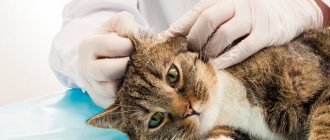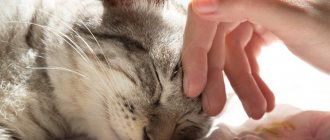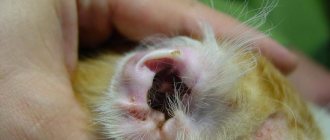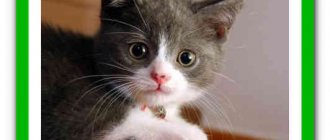Skin diseases are a common occurrence in domestic and farm animals. Pathologies manifest themselves in different ways: hair loss due to attack by parasites, problems with the epidermis and internal disorders. The causes of these symptoms need to be accurately determined. The veterinarian will not only identify the disease, but also prescribe the correct treatment. Some skin diseases can be dangerous to your pet's health.
Causes of sores throughout the body in cats
Damage to the skin is caused by sources of various types. These may be hereditary, infectious or anthropogenic (man-made) factors. The condition of the skin is affected by food changes, poor water quality, or even stress caused by moving to a new place of residence. Scabs, ulcers, and small wounds progress quickly without timely treatment. They cause the pet great discomfort and pain. The cat becomes nervous, scratching the affected areas.
Some ailments do not have obvious manifestations. It is possible to notice pathology only with a thorough examination of the animal. The most obvious is refusal to eat, apathetic state, and constant scratching. The wounds can be of different shapes and colors. They have one thing in common - this is an external manifestation of a serious internal disease.
The main factors may be:
- poor nutrition;
- genetics;
- allergies;
- bacterial and fungal infections;
- blood-sucking or intestinal parasites: ticks, fleas, worms;
- weak immune system.
This diversity means that pathology may well occur in almost any mustachioed friend. There are many specific reasons for this. A specialist in a veterinary clinic can find out the cause of the appearance of ulcers, wounds or scabs, as well as select the correct therapy.
Dermatitis in cats
There are many types of dermatitis. Some of them occur without exacerbations, others can even lead to death. If a cat has sores all over its body and is accompanied by hair loss, then most likely it is lichen. The disease is dangerous not only for kittens and cats, but also for people. Therefore, urgently go to the vet. Once the diagnosis is confirmed, the cat will be prescribed treatment with ointments and special shampoos.
In case of lichen, prophylaxis is carried out for all animals and people who have been in contact with an infected pet.
There is also bacterial dermatitis. If the pet is infected, then purulent sores are observed on the cat’s head and throughout the body. Animals with weak immunity, mainly kittens under one year of age, are at risk. Treatment is prescribed by a veterinarian, mainly a course of antibiotics.
Diseases with skin lesions
It is worth taking a closer look at the health problems that cause the uncharacteristic appearance of the skin and coat. Each illness negatively affects the external and internal condition of the pet.
Bacterial and fungal infections
Infections with pathogenic organisms occur in different ways. For example, the dry type of infection causes the appearance of dry, compacted crusts on the surface of the body. The wet form is characterized by redness, ulcers, scratching and severe itching. The reasons for the penetration of infections are varied:
- metabolic disorder;
- diabetes;
- neoplasms of various types;
- weakened immune system;
- superficial wounds.
Treatment is carried out only by a veterinarian after a thorough examination and laboratory tests. One of the most unpleasant and contagious lesions is lichen, which is transmitted to other animals and humans.
It is impossible to choose on your own how to treat a cat’s scratching: to do this, you need to determine the type of pathogen. This can only be done in a veterinary clinic laboratory.
Parasites in cats
One of the most common causes of wounds on a pet’s body is parasites that choose warm areas on its surface. For example, the neck and axillary parts are very attractive to them. Parasites are external blood-sucking pests - fleas or mites, including scabies).
It is not the fleas themselves that cause discomfort, but the products of their activity. The saliva released when a wound is bitten contributes to the onset of allergic irritations. The pet scratches in this area due to severe itching. This is how pathogenic microorganisms appear in the wound, which trigger complications of the disease.
Skin pests are easy to spot. To do this, you just need to examine the body and head of your mustachioed friend. If parasites appear, it is necessary to carry out timely treatment to stop the spread of the infection. In any case, it is important to consult a veterinarian. He will examine the patient and determine that the appearance of sores in the cat is indeed associated with bloodsuckers.
Ticks are much more difficult to see. Subcutaneous individuals are found only by a doctor after a thorough examination and special tests. Treatment is most often prescribed in the form of drops on the withers or tablets. The drug "Ivermek", which is used as intramuscular injections, has proven itself well. The course of injections is 30 days, during which 3 vaccinations are given with a medicinal solution.
A similar product can also be purchased in the form of an ointment or gel. It is applied to the damaged surface after consultation with a veterinarian. Do this at home strictly according to the instructions.
It is important to remember that fleas do not pose a direct threat to your pet's health, but scabies can lead to death. Ticks not only spread under the skin, but also parasitize internal organs, so it is important to start treatment as soon as possible.
Allergic manifestations in cats
Sometimes sores on a cat’s skin occur due to allergies to external irritants. For example, purchasing a new brand of industrial food can lead to malfunctions in the body, which will manifest itself in the form of skin pathologies. It is possible to determine the cause of such a reaction by visual inspection and conducting special tests to recognize the allergen.
In addition to food, the body can react to dust, chemicals or hygiene products. Even inhaling ordinary washing powder leads to unpleasant consequences. There are times when sensitive cats react to blooms. The test, performed in a hospital setting, will identify a group of foods or other substances that need to be removed from the pet. If this is not done, the cat will have to be constantly given medications.
Dermatitis in animals
There are different types of skin dermatitis. Some of them have no complications, while others lead to death if treatment is delayed. They can be both bacterial and fungal, and are also caused by mechanical damage.
The bacterial type of dermatitis manifests itself as ulcers on the body and head of the pet. Animals with weakened immune systems, as well as babies under 1 year old, are at risk of getting sick. Once the pathogen is identified, the doctor prescribes antibiotics.
Less dangerous, but just as unpleasant, are dermatitis caused by seborrhea or injury. In the first case, the cat develops dandruff, and the animal begins to constantly itch in different places. In the second case, a simple wound can fester and cause sepsis, which in many cases leads to death.
Acne on a cat's body
Acne is blackheads with hard crusts. Acne with the appearance of open and closed comedones is usually localized on the neck, chin and lips of the cat. The cause of acne is considered to be poor hygiene, infections, stress, and abnormalities in the sebaceous glands and hair follicles. Even low-quality plastic from which the bowl is made can cause acne. Contact with cheap material can cause unpleasant rashes - it all depends on the sensitivity of the individual.
Another symptom is slight hair loss. If the disease is not treated, ulcers, purulent pimples, inflammation, and bacterial infections appear. After making a diagnosis, the veterinarian prescribes antiseptic detergents: medicated shampoo, soap. In addition, lips, chin and other areas affected by acne are treated with Miramistin or Chlorhexidine.
Other lesions
Even psychogenic factors cause ulcers and crusts on a pet’s body. For example, Cushing's syndrome is manifested by baldness of certain areas of the skin. Fortunately, this syndrome is rare in pets: it appears due to too much of the hormone cortisol. The disease has other pronounced symptoms:
- strong thirst;
- frequent urination;
- constant feeling of hunger with subsequent enlargement of the abdomen;
- lethargy, muscle atrophy;
- thin skin, baldness.
Doctors often prescribe medications that can suppress large releases of cortisol into the blood. In severe cases, the pituitary gland, adrenal gland are surgically removed, or chemotherapy is used.
Another skin problem is alopecia. Loss of fur also occurs under the influence of neuroses. They can be caused by a change of place of residence, the appearance of a new owner, or meeting a new family member. Some breeds are most prone to pathology: these are Abyssinian, Himalayan and Siamese cats.
Baldness is focal. Most often it appears on the abdomen, groin area, sides or inner thighs. Sores rarely appear on a cat's neck. The medications Kot Bayun, Amitriptyline, and Stop-Stress help to cope with the problem.
Allergic reaction in cats
My cat has sores on his skin, what could it be? Remember, maybe you changed the food or the animal was recently seriously ill? Even purchasing a new vitamin complex can cause an allergic reaction on the skin . The diagnosis is very imprecise; allergies can only be determined by a veterinarian using tests for groups of allergens and a visual examination of the animal.
However, food allergies are not the only option, but one of many. Your pet may react to dust or hygiene products.
Even regular laundry detergent can be an allergen.
You can find out why sores form using an allergen test. You can easily see what it looks like in photos on the Internet. When a group to which the cat has a reaction is identified, it will be necessary to protect it from this type of exposure. Otherwise, the pet will have to constantly be on medication.
© shutterstock
The danger of skin pathologies for humans
Despite the fact that such diseases are an unpleasant phenomenon, most of them are not transmitted to people. Timely and correct prescription of medications makes them not dangerous for their owners.
Infection with different types of lichen and allergic reactions from blood-sucking bites require the use of medications not only for the animal, but also for the owner. They do not pose a threat to life, but the spread of scabs and ulcers throughout the body of a person or pet is not a very pleasant phenomenon, and it needs prompt treatment.
Are cat diseases dangerous for humans?
Most feline skin diseases do not pose a danger to humans, but it is recommended to wear gloves when caring for an unhealthy animal. Some bacteria and fungi are not able to penetrate a healthy body, but can cause harm if the immune system is weakened.
The only contagious disease listed is ringworm. In humans, it manifests itself as flaking, spots, itching and hair loss. To prevent infection, you need to minimize contact with the cat and wash your hands with soap after handling the animal.
The main danger of dermatological feline diseases lies in the increased risk of developing allergies in humans. When an animal is sick, its skin is renewed more often, and dander and saliva particles get into the air. These are potential allergens. The more irritant enters the human body, the higher the risk of unwanted reactions. Such diseases are most dangerous for those who already have allergies. To prevent attacks, it is recommended to do wet cleaning more often.
Treatment of skin diseases in cats
Before visiting the hospital, you should prepare to answer questions about your mustachioed friend's condition. The doctor will definitely ask when the ulcers or scabs appeared and ask about diet and seasonal diseases. Having received complete information, the doctor will prescribe special tests and tests:
- biopsy;
- blood analysis;
- scrapings or smears;
- ultraviolet examination.
After laboratory tests, it will not be difficult to understand what caused the cat’s sores throughout the body. Often, a domestic cat is switched to a special diet containing mainly hypoallergenic foods. Vitamin and mineral complexes help restore the immune system. A course of antibiotics is most often accompanied by the use of probiotics to strengthen a weak body.
Sometimes medications can worsen a pet's condition. New symptoms or wounds begin to appear - this is an allergy to medications. In this case, the drugs are discontinued, and new medications are introduced with caution instead. The pet should be constantly monitored so as not to miss any unpleasant responses. If the cat’s condition has not worsened, then the course of therapy should be continued.
Most pet owners try to get rid of severe itching as quickly as possible. Indeed, if you eliminate this symptom, your pet will scratch the skin less and it will begin to heal. If scabs appear on the neck or head, a special collar is put on the animal. Eliminating itching without background therapy cannot be called the correct treatment, because it does not stop the root cause.
Buying medications on your own is strictly contraindicated, because this can lead to deterioration of health. Proper treatment promotes a quick recovery, and regular checks of the cat’s fur will be a good preventative measure against the spread of skin pathologies.
Treatment options
Treatment methods depend on the identified disease. If an animal has an allergy, it is necessary to identify the irritant and eliminate it. Tests can be done to do this, but most often they are not done due to the wide range of potential allergens and the high cost. They try to identify the irritant on their own.
First, they change the food to an analogue with a completely new composition. If the animal eats natural products, the menu is gradually reduced and the reaction is checked. If a pet's allergies are seasonal, access to the street is blocked to prevent pollen from entering the body.
Eliminating the irritant does not always immediately produce results. Most often, it takes several weeks for the condition to improve. At this time, you need to monitor the animal and immediately report any deterioration to the veterinarian. If complications arise, the specialist may prescribe antihistamines.
For lesions of a bacterial, parasitic or fungal nature, appropriate medications are prescribed. Before this, it is necessary to clarify the pathogen strain in order to select the most effective remedy. If the lesion is local and small, external agents can be used. For the generalized form, tablets and suspensions are taken.
In the absence of deep wounds in the later stages, the veterinarian may prescribe herbal baths. This will prevent the formation of weeping eczema. Additionally, anti-inflammatory drugs can be used. They will ease the itching and facilitate the healing process.
Possible causes of itching
Often, a domestic cat often washes and scratches its neck behind the ears, its muzzle, tears the skin on its head and scratches itself so that its hair falls out or sores appear until it bleeds and scabs and scabs, and to find out why this happens and how to treat it, first The first thing you need to do is check whether he has fleas or not.
If blood-sucking insects or their eggs are detected, you will need to immediately treat the animal’s fur with special preparations. If no fleas were found during examination of the animal, then the cause of the itching may be as follows :
- skin diseases;
- hormonal disbalance;
- allergic reaction;
- endocrine gland disorder;
- lichen;
- the presence of parasitic worms (helminths).
To eliminate itching and protect a cat living at home from scratching its neck, back and other places, it is necessary to identify the source of its occurrence and carry out effective treatment. Next, the possible causes of the disease are discussed and what to do if the cat often licks itself until it hurts, what to give if it is constantly itching.
Therapeutic techniques
How to treat a weeping wound on a cat? In mild cases, they resort to “open”, “dry” wound treatment. This does not mean that the damage is left open to environmental factors. Its purpose is to create the most favorable conditions for wound healing by the body itself. Sometimes a simple bandage is quite enough for healing by secondary intention, but for this to happen several factors must coincide:
- The regeneration process is progressing well.
- It is important to prevent the formation of large scars, which can impair the functionality of the damaged organ or reduce the breeding value of the animal.
- The patient tolerates the dressing without tearing it off every two minutes.
Precautions for fungal infections in domestic cats
The disease is anthropozoonotic – that is, transmitted from animals to humans and vice versa. Children and the elderly, as well as those weakened by other diseases, are most susceptible to infection with the fungus.
Therefore, if there are children, old people or seriously ill people in your house, then of course the most optimal solution would be to isolate the sick animal in another room until it has fully recovered.
If the inhabitants of your apartment are all adults and healthy people, then it will be enough to treat the cat’s skin with ointments, wearing gloves and a mask, carry out daily wet cleaning using antiseptics, iron the fabrics with a hot iron, and wash your hands.
Diagnostics
The veterinarian will examine the cat's head and neck, paying special attention to the scabs and the areas around them. Be sure to conduct a survey of the owner, during which they find out how long ago the first symptoms appeared, in what conditions the cat lives, what he eats and what he has been sick with recently.
Based on the clinical picture, the following diagnostic examinations are carried out:
- examination of the skin under ultraviolet light;
- biopsy of samples taken from scabs;
- general blood tests;
- bacteriological examination of smears or scrapings from scabs;
- allergy tests using special test strips.
Until a diagnosis is established, it is advisable to isolate the animal or minimize contact with household members.
Diagnostic and therapeutic measures
The next possibility is the presence of an infectious or parasitic disease: skin mites (for example, demodex) or fungal diseases. In this case, the clinic offers the following tests:
- A general blood test to check for the presence of an inflammatory process.
- Scraping from the surface of the wound to determine the type of mite.
- Smears are impressions from the surface of the wound. They are studied under a microscope to determine the type of pathogen: fungi, bacteria, etc.
- Plucking and examining animal hair under a microscope.
- Luminescent diagnostics – detects some types of fungal diseases.
- Tissue culture is used for more severe symptoms.
Medical treatment of all types of skin diseases, including if a cat’s neck wound does not heal, requires an integrated approach. Antihistamines are prescribed (to reduce itching), antibiotics to remove secondary microflora for 10-21 days, local preparations in the form of ointment, lotion, cream and medicated shampoos (based on chlorhexidine or antifungal components) for bathing 1-2 times a day. week. A 1.5-2 month diet will be a must.
Under no circumstances should “human” medications be used in pediatric dosages. When treating pets, the dose of the drug is specific and is calculated by a veterinarian based on the weight of the pet and the type of animal. A different dosage may worsen the situation.
The last and more typical occurrence of a wound on a cat’s neck is the pet’s pugnacity. In the heat of mating season or during the development of territories adjacent to the house, cat fights are very common. Naturally, after battles, the cat trudges back hungry, exhausted and wounded. If blood oozes out of the wound, you should immediately contact a veterinarian.
The risk of losing a pet from bleeding is very high.
In case of only skin injuries without blood loss, you can help yourself. Proceed as follows:
- disinfect the wound with 3% hydrogen peroxide;
- treated with Chlorhexidine solution for 5-7 days;
- Levomekol ointment is applied to the wound;
- the wound should be bandaged or a veterinary collar should be purchased, since cats often lick their wounds, and there is nothing useful in their saliva. This will only interfere with healing.
Wound treatments are carried out twice a day: morning and evening. If the wound is extensive, you should contact a veterinary clinic for antibiotics and suturing of the wound.
In conclusion, we note that if it is impossible to help your pet on your own, you should not waste time and money in contacting a specialist. Only a doctor can prescribe tests and make the correct diagnosis. Don’t forget: “We are responsible for those we have tamed.”
Skin diseases: causes, symptoms, treatment and prevention
There are so many skin diseases that affect cats that it is simply impossible to present all the available data about them in one article. However, there is a group of dermatological diseases that are most often diagnosed in these pets. It includes infections caused by various bacteria and fungi, pathologies caused by mites (demodex, otodectosis), lichen, psoriasis, acne, bedsores, allergies, bumps and other formations on the skin.
Bacterial infection
The most common cause of bacterial infections in felines is staph. This type of skin disease in pets can be recognized by a number of symptoms. Manifestations of the disease and its treatment depend on the form of the pathology. Information about how infections of bacterial origin occur in these animals and how they are treated is presented in the table:
Dry form of bacterial infection
| Forms of bacterial infection | Symptoms | Treatment methods |
| Dry | Dense formations and crusts on the skin. | To eliminate signs of infection, depending on the clinical picture, the four-legged patient is prescribed oral antibacterial drugs (Amoxiclav, Cefoxitin, Clindamycin, Cephalexin) and topical agents (Miramistin, Levomekol, zinc ointment). Also, medicated shampoos (Api-San, Elite) are indicated for a sick pet. |
| Wet | Hyperemia and moisture in the affected areas of the epidermis, accompanied by rashes, the formation of ulcers and weeping crusts, and itching. |
Fungal infections and different types of lichen
This type of skin disease, also known as “lichen,” is caused by fungi; less commonly, it occurs due to viruses, a nervous breakdown, hormonal imbalance, or allergies. Most often, the epidermis is affected by fungal infections Trichophyton Microsporum canis and Microsporum gypseum. If treatment is started in a timely manner, the animal can be cured in 21 days. If the deeper layers of the skin are affected, complete recovery may take up to 6 months. Information about the types of lichen (their photographs are posted below) in cats is presented in the table:
Ringworm
| Types of lichen in cats | Symptoms | Treatment |
| Shearer |
|
|
| Pityriasis (multi-colored) |
| |
| Pink (not fungal etiology) |
|
|
| Weeping (eczema, caused by hormonal imbalance, stress, etc.) |
|
|
Ear mite
Fungi can also infect the outside of your pet's ear. Most often, otomycosis is caused by Aspergillus or Candida. This disease is accompanied by severe itching, redness, slight discharge of purulent exudate, and greenish-gray or pure gray deposits.
Damage by ticks
The most common diseases in cats caused by ticks are demodicosis and otodecosis. The causative agents of the first disease are opportunistic ticks Demodex cati and Demodex gatoi, the second is Otodectos cynotis. Most often, infection occurs in the warm season. A detailed description of the symptoms of these diseases and how to eliminate them is presented in the table:
Demodectic mange in a cat
| Diseases caused by ticks | Symptoms | Treatment |
| Demodicosis |
|
|
| Otodectosis (ear mites) |
|
|
What is a weeping wound, the reasons for its occurrence
This is a wound whose surface is not contracted by granulations and does not heal. It literally oozes ichor or necrotic exudate. The color and smell of the exudate resembles rotting meat slop. It is necessary to distinguish a weeping wound from an ulcer: in the first case, a skin defect occurs as a result of mechanical action, in the second it is only a consequence of some severe metabolic disorders or hormonal metabolism in the body (a good example is ulcers due to diabetes or uremia).
When is it necessary to consult a veterinarian?
In most cases, dermatological diseases in cats are treated at home and do not pose a threat to life. However, there are situations in which mandatory veterinary assistance is required. Sometimes self-treatment of a pet can lead to serious and even tragic consequences. Reasons for visiting a veterinary clinic should be:
- increase in pet's body temperature;
- decreased motor activity and lack of response to external stimuli for a long time (more than 24 hours);
- refusal of food and water;
- inability to rise independently;
- bleeding;
- uncontrollable vomiting;
- diarrhea;
- suppuration in the eye area;
- impaired respiratory function (urgent treatment measures are required if the pet is breathing heavily and wheezing or if its breathing is rapid and shallow);
- blood in urine or stool;
- a plaintive meow for no apparent reason.











